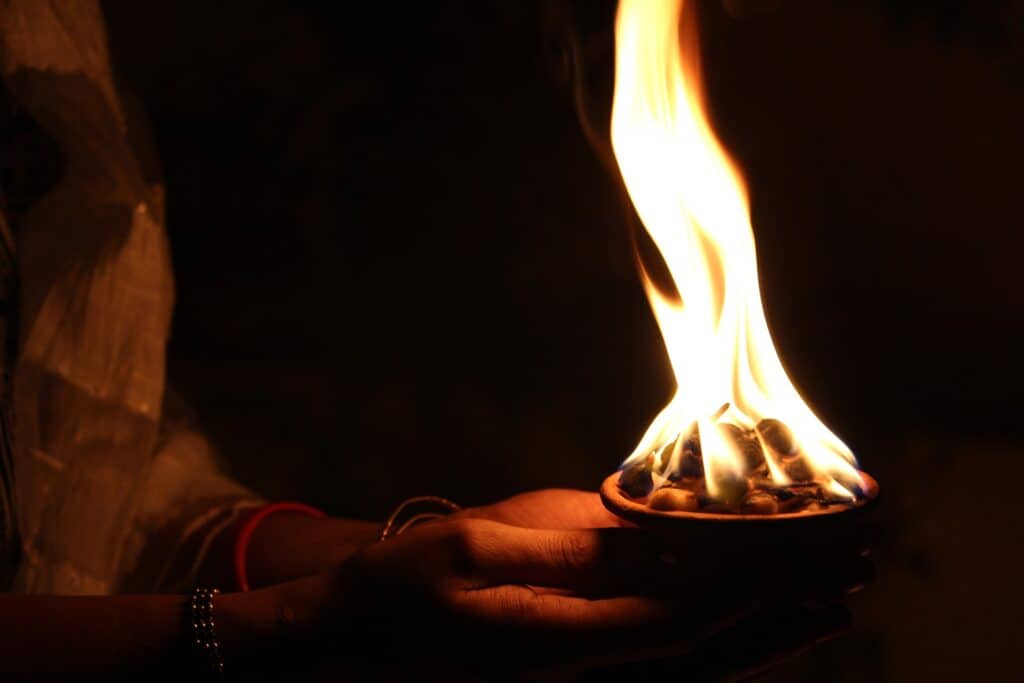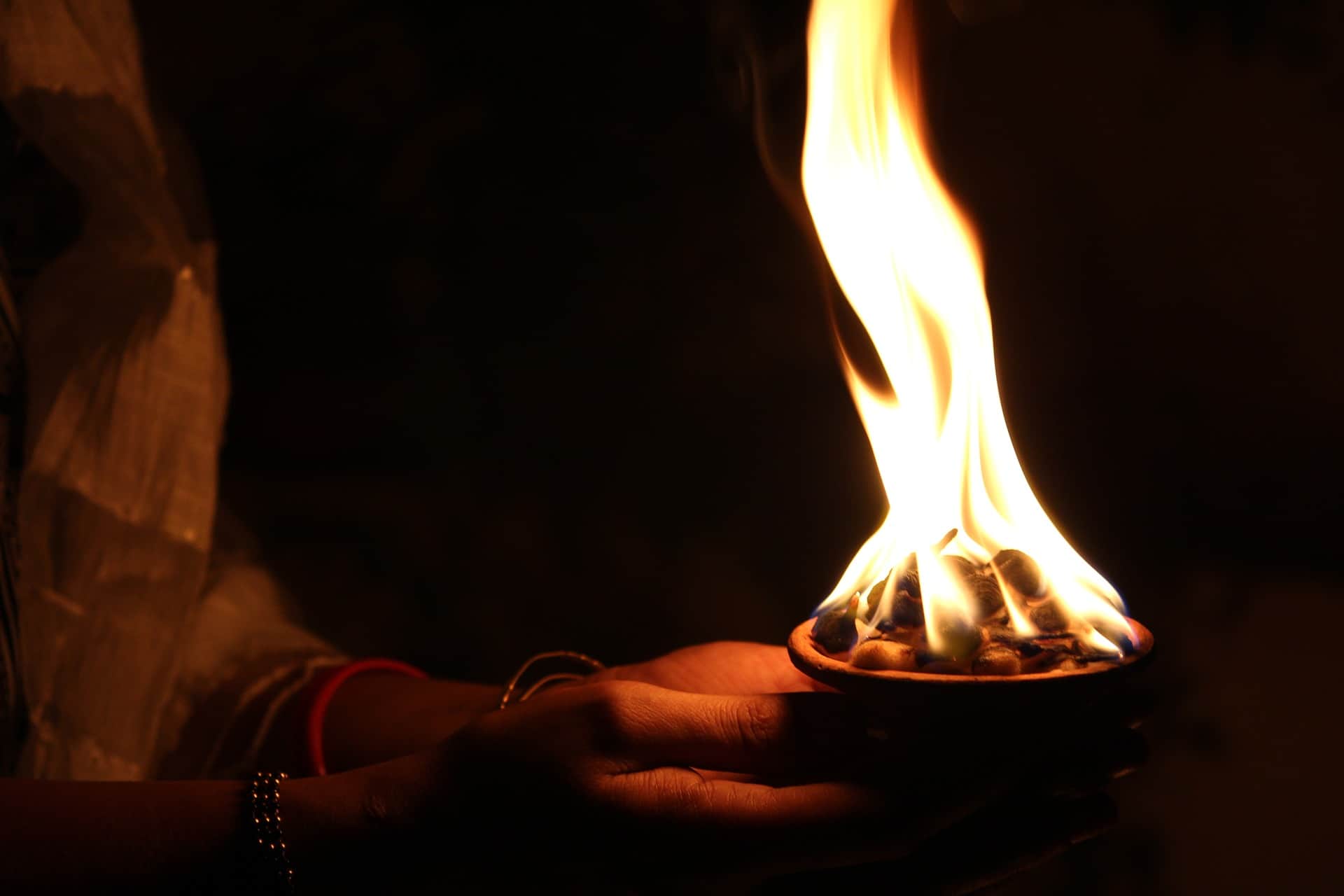Introduction
Aarthi/Harati is a part of Hindu puja and the ritual is performed at the end of worship. The practice of waving lamp in front of one or more deities exists since the Vedic period. Aarti means the lamp of fire pursued with the hands along with ringing the bell.

The ritual is performed both in temples and houses. The importance of Aarti and related ceremonies are explained in detail in this article. Desperate the article ensures the ritual and its existence since the ancient period.
What is the Aarti ceremony?
In general, Aarti is performed along with singing hymns and songs praising the deity of worship. The ceremony occurs at the end of worship or puja. Camphor, incense sticks are used to wave in front of gods also lamp filled with ghee or oil used for the same purpose.
Conducting Aarti declares the end of worship or puja. The Aarti plate is made of metal either silver, copper, or bronze on which is placed the lamp made of the same metal or mud. The cotton wicks are used to light fire and oil or ghee helps the lamp withstand for hours.
If you want to buy good quality Aarti plates/thalis and Camphor Burner’s Click here.
What does the name Aarti mean?
Aarti is the female name that represents the brightness of the light in other senses. Generally, the person is so creative and determined also bold enough. Throughout India, the baby girl is given the name Aarti followed by the surname.
What is the difference between puja and Aarti?
Puja is the worship of God and is carried away in the houses and temples of the Hindu religion. Home-based puja is carried simply still the ritual is carried something differentiating also lasts for hours. Here there are few points to highlight the major difference between Aarti and puja.
Puja
The worship of god done with homas, yagnas, singing hymns, chanting mantras, etc. The priest will perform the puja and related rituals. Flowers, food, lamps are used in the puja ceremony and offered to the god. Devotees and priests will accept the offerings at the end of puja and numbers of Vedic texts are read while the puja is conducting.
Aarti
This is performed at the end of the puja. The ceremony denotes the end of the session and the lamp is waved in front of the deity rotated in the clockwise direction. This is done twice or thrice and the Aarti is brought in front of the devotee who participates in puja then converges their hands downwards and accepts the lamp of fire. Once the Aarti is accepted, it is believed that deity blesses the devotees.
How many times can you do Aarti?
Many have been told about Aarti and the conditions applied to perform the ritual. Puja Aarti may be simply designed or complicated depends on the length of the worship.
One to five times more often and at the end of the puja is alone the Aarti given to the deity. In South India, Aarti symbolizes the end of worship but in the case of North India, it is done amidst of Bajan session. A person with spiritual importance is given Aarti apart from the deity statue. The lamp of fire is rotated in the clockwise direction one to five times in front of the deity. Devotees get immersed in the faith of God and attain the spiritual motivation along with gratitude.
Where does Ganga Aarti happen in Varanasi?
Ganga Aarti is the most familiar and well known spiritual performance that is held in three important cities of India like Haridwar, Rishikesh, and Varanasi. The spiritual performance is held every dusk as an offering to mother Ganga as a remembrance she descends from heaven earth.
Just like other cities, Ganga Aarti in Varanasi takes place dramatically with uniformly dressed young priests assembled in order at the banks of River Ganga. The priests undertake the rituals along with circling of lamps and incense along with clanging of bells. The ritual is carried in front of River Ganga as a tribute. Unlike the other two cities, Ganga Aarti in Varanasi is a very much bigger event held at Dashashwamedh ghat. At the end of the Aarti ceremony, devotees cup down their hands over the flames and raise the palms to the forehead symbolizing the blessing of the deity or River Ganga.
Why do we ring the bell/Ghanta while doing Aarti? What does ringing the bell symbolize?
Ringing the bells amidst of puja ceremony is considered auspicious in Hinduism. In Hindu temples and homes, puja is carried to worship the deity and at the end of the ceremony, the Ghanta bells are ringing along with the Aarti ceremony. This symbolizes the devotees immerse themselves also dispels the evil away from the area.
Still, Ghanta bells hung in the temple been rang by the devotees. The bells hung in the sanctum area used to rang by the devotees as they enter the temple. Devotees ring the Ghanta bells while entering the sanctum just as a sign of intimating his/her arrival. Ringing the bells is considered an auspicious sign or signal.
The dome-shaped or curved body represents the Ananta but the tongue represents the goddess Saraswati. The handle of the bell symbolizes the supreme power or the divine strength.
Which metal is used in temple bells?
The temple bells are not just a bell alone and not made of a single metal. A huge scientific phenomenon resides behind the temple bells. Very natural the temple bells are made of a mixed combination of many metals like copper, tin, bronze, etc. A significant reason lies with the metal combination that illustrates the frequency of the ringing sound. The huge bell made of will produce the dense sound with a small frequency. However, the bells used by the priest within the sanctum are made of silver metal that produces more sharp and cute sound than any other metal bells.
Hence, the bells are used in the temple and used at the time of the puja and Aarti ceremony. Even so, the bells are rung to inform the arrival of the devotee.

